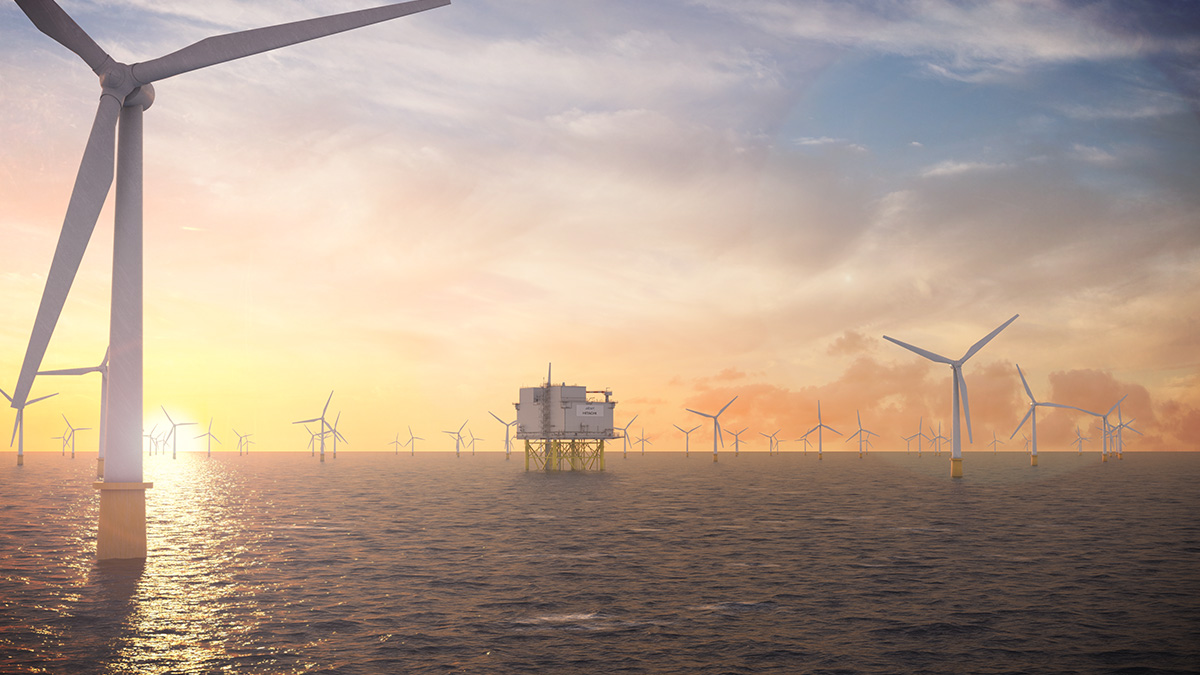News
Meshed grids the next frontier in leveraging the potential of offshore wind

© Hitachi Energy / Aibel
25 April 2023
Europe has placed offshore wind at the heart of its energy transition. Governments across Europe have between them pledged 150 GW by 2030. And by 2050 Europe’s seas will have as much as 450 GW of wind farms. But delivering this requires major investment in grid infrastructure too.
Hitachi Energy and WindEurope have published a new report that shows that Europe needs to invest hugely in offshore grids to facilitate the big amounts of new wind farms and the development of a so-called meshed grid will be essential for Europe’s offshore wind development. These are clusters of offshore wind farms with fewer cables connected to the shore that can route power to two or more national grids.
The development of offshore grid infrastructure has been relatively uncoordinated until recently. Wind farms generally have been connected to one connection point with little coordinated planning for future development. Subsea interconnectors are also primarily used to connect only two separate national transmission systems.
This is starting to change. Offshore hybrid wind farms connected to more than one national grid exist already. The Kriegers Flak wind farm connects the Danish and German grids. And more countries want to combine transmission assets with offshore wind farms. These offshore hybrids save money and space and they enhance energy flows between countries.
The natural evolution of offshore hybrid projects will see them connected to each other to form meshed offshore grids. This will require a full-scale offshore grid deployment and reinforcement of the onshore grid.
Energy islands will be a key stepping-stone for meshed offshore grids too. Belgium, the Netherlands and Denmark have all announced plans to build these islands. They will not only serve as hubs gathering electricity from surrounding wind farms and transmitting it to neighbouring grids, they will also position wind power as a beacon of regional cooperation.
The technology to build these grid solutions is available but it needs to be deployed at scale and more quickly. Developers will need more clarity at European level to mitigate investment risks in order to accelerate the deployment of hybrids. National Governments also need to provide a clear governance framework. The current point-to-point connection approach is relatively clear. And while the evolution of meshed offshore grids is a great opportunity that will help to maximise the penetration of renewables. We also need to address new complexities presented by multiple terminals, vendors, connecting clusters of wind farms and markets including the need for an effective governance model.
The development of an offshore meshed grid also requires resilient supply chains and visibility of project developments across a longer time frame. But we need more than just the technology for the creation of an offshore meshed grid. Policymakers need to plan for these expansions accordingly and industry players need to come up with innovative business models. Moreover, one of the key topics that needs to be addressed is the people resources and skills to execute the energy transition.
Cross-border and cross-sector coordination and cooperation will be pivotal to capture the full societal, environmental, economic, and technical value of meshed offshore grids. Initiatives such as the North Seas Energy Cooperation will be key to ensure effective coordination from planning to operation stages.
WindEurope CEO Giles Dickson said: “European Governments have set ambitious offshore wind targets. But we need to focus on grids too. Huge investment is required to connect all these new offshore wind farms to energy consumers. The best solution is to develop a meshed offshore grid which connects multiple national grids to each other. Governments need to be clear about their future plans. A meshed grid requires deep cross-border and cross-sector cooperation. It will also require investments in supply chains and skills.“
Hitachi Energy’s CEO Claudio Facchin said: “Electricity will be the backbone of our evolving energy system and offshore wind as an integral part of the energy mix will play a crucial role in helping us to achieve our carbon neutrality vision. The evolution of point-to-point offshore connections towards offshore hybrid projects and offshore grids is a great example of technology innovation and will deliver significant environmental as well as socio-economic benefits. Collaboration and coordination across geographies, sectors and stakeholders will be a key success factor in turning this vision to reality.”

